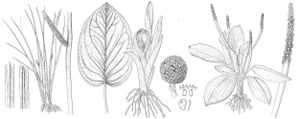Symplocarpus foetidus
Veg. Mater. Med. U.S. 1: 123. 1817.
Roots fleshy, contractile. Rhizomes thick, to 30 cm or more. Leaves: petiole sheathed basally, 5–57 cm; blade thick, 10–60 × 7–40 cm; primary lateral veins parallel, branching apically, interprimary veins anastomosing. Inflorescences at ground level; spathe hoodlike, 6–13(–18) cm, fleshy, apex acuminate, twisted or incurved, not persisting in fruit; spadix short-stipitate, somewhat flattened dorsiventrally, 2–3 × 1.5–3 cm. Flowers covering spadix; tepals 4, yellowish to dark red-purple; stamens 4, dehiscing longitudinally; ovaries 1-locular; ovules 1. Infructescences dark purple-green to dark red-brown, globose to oblong or ovoid, 4–7(–10) cm. Seeds brown, 7–15 mm diam. 2n = 60.
Phenology: Flowering late winter–spring.
Habitat: Swamps, wet woods, along streams, and other wet low areas
Elevation: 0–1100 m
Distribution

N.B., N.S., Ont., Que., Conn., Del., D.C., Ill., Ind., Iowa, Maine, Md., Mass., Mich., Minn., N.H., N.J., N.Y., N.C., Ohio, Pa., R.I., Tenn., Vt., Va., W.Va., Wis.
Discussion
Disagreement exists regarding correct author citation of the combination Symplocarpus foetidus. According to J. T. Kartesz and K. N. Gandhi (1992), concluded that the correct citation is S. foetidus (Linnaeus) Nuttall. The citation I have adopted is S. foetidus (Linnaeus) Salisbury ex W. Barton because Barton, in his 1817 publication, did not specifically attribute this combination to Nuttall; he did cite Salisbury in his first mention of the name S. foetidus.
Symplocarpus foetidus was included as occurring in Manitoba (H. J. Scoggan 1957) based on a misidentified specimen (B. Boivin 1967–1979, part 4). Although the species has been listed for Georgia (W. H. Duncan and J. T. Kartesz 1981), I have seen no specimens from that state. A specimen collected by S. B. Buckley labeled Hab. Florida is probably an error.
When bruised or broken, all parts of Symplocarpus foetidus give off an unpleasant odor. Various species of insects, including those from the orders Diptera, Coleoptera, Hymenoptera, and Hemiptera, many of which are attracted by the odor, have been collected from the inflorescences (W. W. Judd 1961), but the specific mechanism of pollination remains unknown. Although insects are likely pollen vectors, wind tunnel observa tions of the inflorescence suggest a capacity also for wind pollination (S. Camazine and K. J. Niklas 1984). Whatever the pollination mechanism, fertilization is limited, and few inflorescences develop into infructescences (J. A. Small 1959, personal observation).
Symplocarpus foetidus, in various forms and often combined with other plants, was used medicinally by Nnative Americans for a variety of ailments, including swellings, coughs, consumption, rheumatism, wounds, convulsions, cramps, hemorrhages, toothaches, and headaches (D. E. Moerman 1986). Skunk cabbage was officially listed as the drug "dracontium" in the U. S. Pharmacopoeia from 1820 to 1880 for treating diseases of respiratory organs, nervous disorders, rheumatism, and dropsy (A. Henkel 1907). Plants are sparingly cultivated as a curiosity in North American gardens and are reported to be highly prized in aquatic gardens in European estates and public parks (F. W. Case 1992).
Selected References
None.
